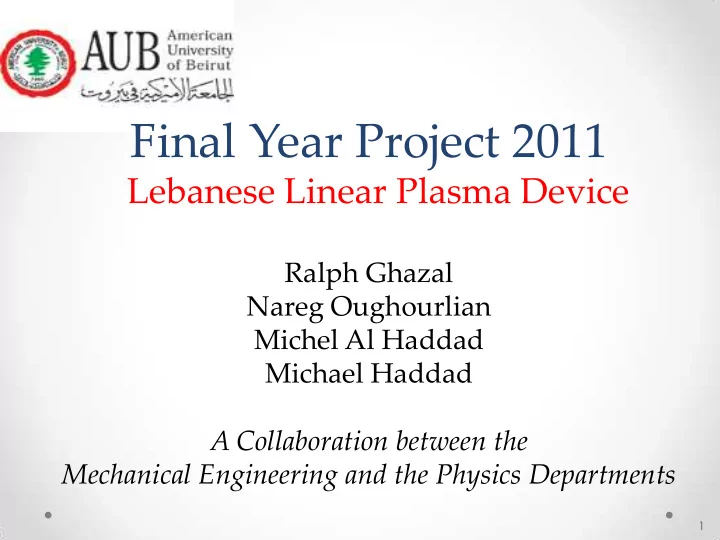

Final Year Project 2011 Lebanese Linear Plasma Device Ralph Ghazal Nareg Oughourlian Michel Al Haddad Michael Haddad A Collaboration between the Mechanical Engineering and the Physics Departments 1
Harvesting Energy From Nuclear Fusion • Nuclear fusion happens when multiple nuclei having the same charge fuse together and form a heavier atom • The difference in mass between the reactants and the products will be the energy we wish to harvest Great Advantages • Vast Fuel Supply • No risk of a nuclear accident • No air pollution or CO2 generation • Low nuclear waste 2
Tokamak, a Fusion Test Reactor Pump down phase: air is pumped out the vacuum chamber to reach a high vacuum. • Gas (in this case it’s hydrogen) is pumped into the vacuum chamber. • An electric pulse ionizes the gas. • Once the ionized particles are near enough to each other, the atomic force takes over and fuses the two molecules into a new one, releasing large amounts of energy in the process. 3
Problem Approach Outline • Decide on the Configurations of the design, and draw the entire linear device on a design software • Design the support structure, with an in-depth analysis of the stresses and mechanical properties that will be required • Design the configuration of the pumping system and pressure control inside the vessel • Design the configurations of the magnetic coils to produce the desired magnetic field 4
Designing the Vessel of LLPD - We proceeded to draw the entire machine on the CAD software PRO-E. - Identify the equipments needed for the three configurations discussed hereafter. - Process to an inventory of the existing vacuum chamber sections. - Draw the existing chamber sections on PRO-E. - Identify and order the missing components. Design 1: Centered source region and long (L= 3.04 m) 5
Design 2: Centered source region and short (L= 2.35 m) Design 3: Edge source region and long (L=3.30 m) 6
Support Structure design Weight distribution Design specifications CAD model Fabrication 7
Design Specifications and Calculations Theoretical CAD drawings Safety Factor Market restrictions Stress analysis and calculations Sizing of the different components 8
Weight Distribution Weight distribution along the system to be supported 30 Weight Distribution (Kg) 25 20 15 10 5 0 A B C D E F G H I J K L 9
CAD drawings PRO- Engineering software 3D model of the parts to be assembled 10
I-Beam sizing Find R1 R2 R3 Consider R1 and R2 for simplicity Shear and moment diagram Maximum moment M max =356.4 N.m given Sy=250 Mpa = 66 11
Leg sizing = 435 N S = 8 cm s = 6 cm
Middle plate sizing Find Weight Shear and moment diagram Maximum moment given Sy
CAD drawings PRO- Engineering software 3D model of the parts to be assembled
CAD drawings (2) System Inventory: 2 H or I beams 6 main legs
CAD drawings (3) Transverse leg supports Longitudinal leg supports
CAD drawings (4) Cross bars S clamps
CAD drawings (5) Wooden arm Upper clamp
Fabrication shop • Material HEA 100 Building the actual device at the fabrication shop Structure delivered to AUB on Friday 27 Mai 2011. 19
The pumping system 20
21
22
Pumps Choice: Viscous flow • Roughing pumps are perfect for this regime • When deciding on a vacuum pump we have taken into account several factors: o Possible oil contamination of the vacuum chamber o Vibrations produced by the pump o Most importantly: absolute pressure reached • System’s specifications: o Base pressure 10 -7 Torrs o Operating pressure 10 -3 Torrs 23
Magnetic Coils - Concept • Surrounding the vacuum chamber, a Magnetic Field is created by a set of magnetic coils mounted on the main support. • Coils are used to confine the plasma. • Magnetic Field : Bmax = 1000 Gauss & Imax = 500 A • We can determine the length needed for each coil L=32.04 m • Each coil is 2x16 turns • Coils are to be designed from copper wires and a cooling system to ensure continuous operation. • Two alternative for design: • > having the coils in series or coils in parallel • Water cooling can be from inside or from outside 24
Magnetic Coils – with External cooling • Coil box is made of Aluminum • Dimensions: o Height: 8 cm o Length & width: 90 cm • Design: o 2 Water inlets on the Front o 1 Water outlet on the Back • 1 Coil I/O on the Front • Upper and lower plate are linked by a cylindrical plate • Inside the coil box we have 8 similar plates • These plates are designed to: o allow the coil to loop 24 mesh o Allow water to circulate 25
Magnetic Coils - with internal cooling • We used copper wires to form coils • Each coil should provide about 450 Gauss. • Each 2-3 coils are hooked in parallel and supplied by one generator. • Some caluclations: • Q box = 1725 W. • 15 coil boxes • Q max = 25875 W • m(dot) = Q/Cp. Δ T = 618.82 grams/sec V(dot)= 37.1292 L/min or Lpm 26
Pictures of Copper wire used 27
Conclusion • One of it kind in the region, and unique properties worldwide. • Adaptable design. • Enabled AUB and Lebanon to partake in the global effort for fusion development. • Delivered to AUB as we speak! 28
THANK YOU 29
Recommend
More recommend